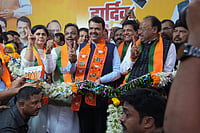Historically, the Vokkaligas were the dominant caste in the old Mysore state. Like the Jats, they are landed gentry. Well-built and fiery, the Vokkaligas led the stir on the Cauvery dispute and reservations for several years and acquired a prime position with their anti-Hindu stand in the '20s and '30s. But their absolute clout began to wither away soon after the reorganisation of states in '56, when the Lingayats, by their sheer numerical strength, became a formidable force. Strict vegetarians and worshippers of Shiva, most of them are businessmen. They are extremely conscious of sub-sects within the community; marrying into another sub-sect is still taboo for Lingayats. Though they continue to be predominant, forming between 14 and 16 per cent of the population against the Vokkaligas' 12 to 14 per cent, the Lingayats are spread thinly across the state.
There have been 10 chief ministers from these two communities so far, with the Lingayats accounting for as many as six. Such domination continued unchecked till '73, when the late D. Devaraj Urs, a backward classes leader, took over the reins. The other odd-leaders-out have been S. Bangarappa and M. Veerappa Moily (both backward castes) and the late R. Gundu Rao and Ramakrishna Hegde (both Brahmins). The tussle goes on even now with the fortunes being dictated by leaders of these communities because they hold key positions in every political outfit. Besides, people of these communities have occupied important positions in the government-technocrats, bureaucrats, economists, and educationists.
Interestingly, the maths of these two communities own several professional colleges and educational institutions in Karnataka. The religious heads of these maths hold sway over the political outfits, and often send out subtle messages to the people during the elections or when a leader's position is shaky.
















